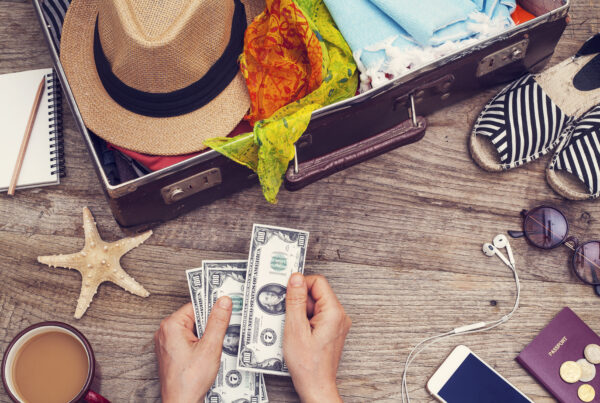When people are saving for a big expenditure—like a new car, tropical vacation, getting married or a down payment on a house—you may hear the phrase, “less is more” as they cut costs and reduce their spending habits.
But what if we told you more is more?
When it comes to saving money, having multiple savings accounts for budgeting purposes is actually recommended. Here’s the scoop on some simple steps you can take to set yourself up for saving success.
You can—and should—set up more than one savings account.
As you explore your options, you’ve likely found that banks and credit unions offer a variety of financial products and services, such as checking and savings accounts, credit cards and loans. But what you may not know is that you can also open a variety of sub savings accounts (also known as secondary savings accounts) with up to 10 secondary savings accounts allowed at most financial institutions. These accounts can be dedicated to specific savings goals.
A secondary savings account lets you set aside funds in a separate savings where you currently take care of your banking needs. For example, at Verve you can have a primary/main savings account with up to 10 sub accounts, also called Name Your Savings. (Or if you have longer term savings goals in mind, a Save to Win or Pick Your Payout account, may help you get the biggest bang for your saved buck.)
Separate and named savings accounts help you see progress toward goals.
Emergency Fund.
Dream Home.
Tropical Getaway.
Sweet New Ride.
A Very Merry Christmas.
Those are just a few sample savings account names that also serve as a motivator to keep saving money when you’re tempted to tap into those funds for other purchases.
Why does naming a savings account help you save more money? By writing down your financial goals and naming a savings account to match those goals, you make those goals feel closer and more real which can help you get excited about saving for the future.
Separate savings accounts also show progress toward goals clearer than one big savings account. Let’s say you have $13,000 in savings and have a goal to set aside $15,000 for a new house, $5,000 for an emergency savings and $1,000 for holiday gifts. By splitting that $13,000 into three accounts, you can portion it out according to the date you have in mind to achieve your goal, as well as set up automatic transfers to savings to help you keep building those savings.
How to organize multiple savings accounts
Before you can organize your savings accounts, you’ll need to know what you’re saving for! It doesn’t have to be a spreadsheet or detailed list but do a little research on how much things costs and jot down a few financial goals. While everyone’s financial picture looks different, here are a few things to consider saving for:
- Emergency Fund: This is the savings account you’ve likely heard about the most, but the one you may still have many questions about. According to a BankRate survey, nearly 60% of Americans don’t have enough in savings to cover a $1,000 unplanned expense (like a veterinarian visit for your fur baby or trip to the mechanic for your sputtering car). If you don’t have an emergency fund yet, we recommend setting a goal of saving $1,000 (which you can have saved up in one year if you set aside $20 a week) to get started. From there, take some time to review your monthly expenses and plan on building an emergency fund that has enough to cover three to six months of living expenses.
- Vacation savings: This is a fun one! Maybe you’ve had your eyes set on a tropical getaway during the cold winter months, or maybe you want to take an epic two-week road trip to check out as many U.S. National Parks as you can. Whatever your ideal vacation is, take some time to dream, write down the amount you need to save, decide when you want to take your trip and set up an automatic transfer to help you get there.
- New car: Just like the name implies, you can set up a savings account to save toward a new vehicle. It can help you have a larger down payment and lower the amount you need to borrow (which means you’ll be paying less in interest in the long run!).
- Tires, car maintenance, taxes or other recurring expenses: There are a variety of expenses that occur once a year, or more infrequently, but carry a larger price tag—such as tires for your sweet new ride.
- Car or home insurance: Did you know you can get a nice discount for paying your car insurance premium in full or every six months, rather than monthly? Set aside a little each month into a separate savings account so you have the funds available.
- Home remodel project: What’s nicer than a new kitchen? A new kitchen that you didn’t have to take a loan out for.
- College/Higher Education: Whether it’s for yourself or a child, setting money aside for college helps reduce the amount needed in loans.
- Retirement: Traveling, winter home, cottage—whatever your retirement plans, save for the life you want.
- Wedding: Give yourself the best wedding gift of all—starting your marriage off WITHOUT a hefty personal loan to pay for your wedding day.
- Baby: Diapers, bottles, clothes and more, set aside money now for all the expenses that come with bringing home a new bundle of joy.
- Pet fund: From pet-sitting costs to grooming to unexpected vet bills (because your fur baby thought it was a good idea to eat your slippers), set aside funds to care for your fluffiest family member.
- Mattress/furniture: Want an adjustable bed, or maybe a new couch? Take the sting off the big price tags commonly associated with furniture purchases by setting aside a few bucks a month.
- Kitchen utensils/pots and pans upgrade: While you may not be ready to part with your favorite pan just yet, all good things must come to an end. But the good news is you can take the financial strain out of buying new kitchen gadgets by saving for them.
- Landscaping: While DIY yard work is often less expensive (and not to mention a great workout), some landscaping projects are better left to the experts.
- New tech: Whether it’s a phone upgrade, home security system, tablet, smart watch or other gadget, a savings account can help you make your technology upgrade dreams a reality.
- Hobbies: Knitting retreat? Comic book convention? Horse Expo? Your hobbies bring you joy, so why not set aside funds to help offset costs?
Not sure if you should focus on paying down debt or building your savings? Meet with one of our team members (virtually or in person) to talk through your goals and set up a financial plan that fits your needs.






 Federally Insured by NCUA |
Federally Insured by NCUA |  Equal Housing Opportunity |
Equal Housing Opportunity |